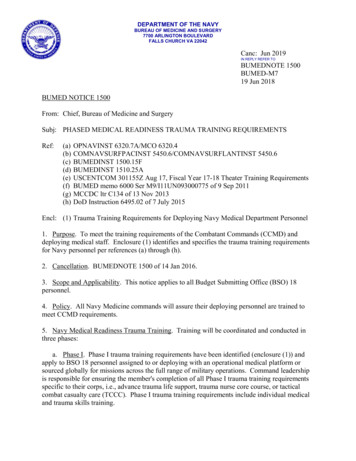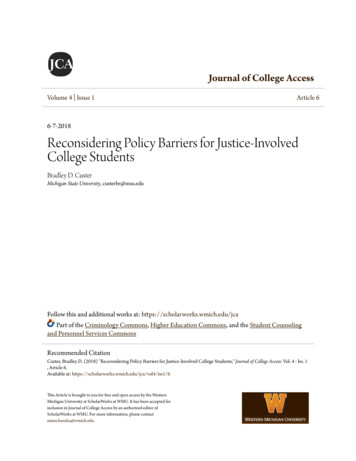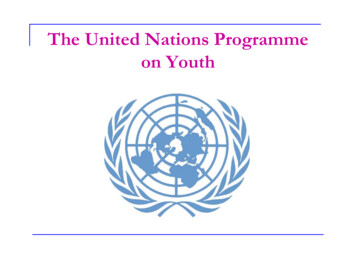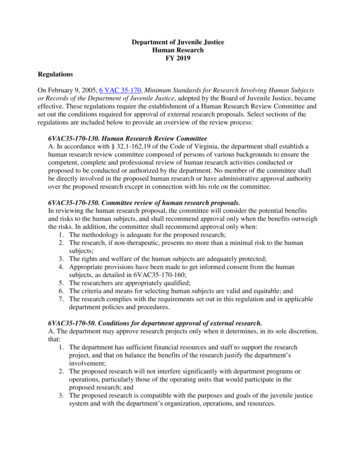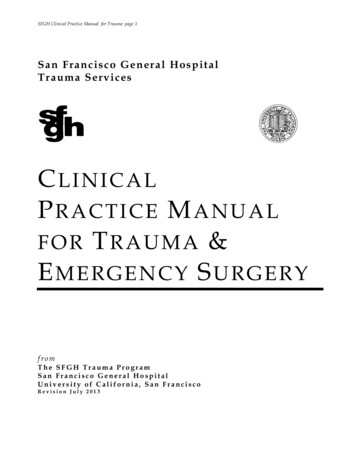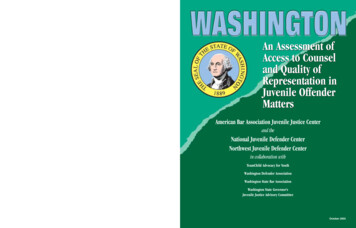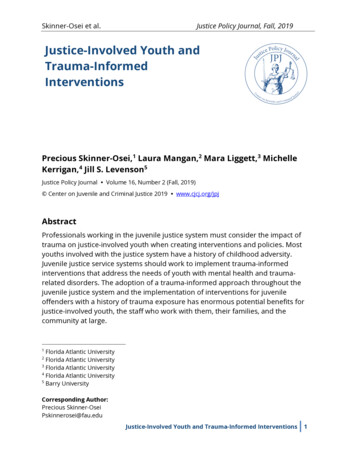
Transcription
Skinner-Osei et al.Justice Policy Journal, Fall, 2019Justice-Involved Youth andTrauma-InformedInterventionsPrecious Skinner-Osei,1 Laura Mangan,2 Mara Liggett,3 MichelleKerrigan,4 Jill S. Levenson5Justice Policy Journal Volume 16, Number 2 (Fall, 2019) Center on Juvenile and Criminal Justice 2019 www.cjcj.org/jpjAbstractProfessionals working in the juvenile justice system must consider the impact oftrauma on justice-involved youth when creating interventions and policies. Mostyouths involved with the justice system have a history of childhood adversity.Juvenile justice service systems should work to implement trauma-informedinterventions that address the needs of youth with mental health and traumarelated disorders. The adoption of a trauma-informed approach throughout thejuvenile justice system and the implementation of interventions for juvenileoffenders with a history of trauma exposure has enormous potential benefits forjustice-involved youth, the staff who work with them, their families, and thecommunity at large.1Florida Atlantic UniversityFlorida Atlantic University3Florida Atlantic University4Florida Atlantic University5Barry University2Corresponding Author:Precious Skinner-OseiPskinnerosei@fau.eduJustice-Involved Youth and Trauma-Informed Interventions1
IntroductionThe United States leads the industrialized world in the rate at which young peopleare incarcerated (Annie E. Casey Foundation [AECF], 2013). Approximately 45,00060,000 youth under age 18 are incarcerated in juvenile correctional facilities andadult prisons on any given day (American Civil Liberties Union [ACLU], 2018;Hockenberry & Sladky, 2018). In 2014, an estimated one million children werearrested (Children’s Defense Fund, 2018). In 2015, 48,043 children were detainedovernight (Children’s Defense Fund, 2018). Although the numbers were declining in2016, an estimated 856,000 children were arrested that year (Children’s DefenseFund, 2018). Incarcerating youth poses lifelong consequences by cutting them offfrom their families, compromising their education, disrupting their socialrelationships, possibly increasing their chance of recidivating, and often exposingthem to further trauma and violence (AECF, 2013; OJJDP, 2016; Hancock, 2017;ACLU, 2018).One out of every 14 children in the United States has had an incarcerated parent(Murphey & Cooper, 2015; Zoukis, 2017). Although a precise number is difficult toascertain, it is estimated that half of justice-involved youth [JIY] in custody have orhad a parent or close relative in custody (Butterfield, 1999). Delinquent behavior isoften a learned behavior and an inherited consequence of their parent’sincarceration. Research has shown that having a parent in jail or prison hasproduced severe trauma in some children, and parental incarceration is one of theten primary adverse childhood experiences (ACEs) identified by the Centers forDisease Control (Skinner-Osei & Levenson, 2018). Exposure to parentalincarceration has shown a significant relationship with delinquency and othermaladaptive behaviors (Felitti, Anda, Nordenberg, Williamson, Spitz, Edwards, &Marks, 1998; Baglivio, Epps, Swartz, Huq, Sheer, & Hardt, 2014; Skinner-Osei, 2018).Parental incarceration can create profound shame and stigma for children andtheir families. When a parent is incarcerated, children are locked behindmetaphorical bars, and they must cope with erroneous and damaging assumptionsfrom their peers, teachers, and even other family members (Skinner-Osei &Levenson, 2018). For many children, parental incarceration is an intergenerationalfamily legacy, mainly because they are at risk of repeating what has been modeledto them (Skinner-Osei & Levenson, 2018; Levenson, 2019).Children in the justice system are often viewed as beyond hope anduncontrollable. They may appear angry and defiant when, in actuality, they arestricken with loneliness, depression, abandonment, powerlessness, and fear (Officeof Juvenile Justice and Delinquency Prevention [OJJDP], 2012). What masqueradesas intentional defiance and aggression is often a defense against the despair and2Justice-Involved Youth and Trauma-Informed Interventions
Skinner-Osei et al.Justice Policy Journal, Fall, 2019hopelessness that traumatic events have caused in their lives (Skinner-Osei &Levenson, 2018). These characteristics are exacerbated by the use of the outdatedand harmful “training school” model that punishes JIY by placing them in remoteprison-like settings (ACLU, 2018). Many youths are incarcerated for non-violentoffenses; primarily low-level property offenses, public order offenses, and statusoffenses, such as possession of alcohol and truancy (OJJDP, 2012; AECF, 2013;Campaign for Youth Justice [CFYJ], 2016).The consequences are far-reaching. Many of these youths are offending due topre-existing trauma stemming from some form of maltreatment and/or familydysfunction. Moreover, abused or neglected children have an increased likelihoodof running away from home (Kaufman & Widom, 1999). Many who run away arebetween the ages of 12-17 and have suffered some form physical, sexual, verbal, oremotional abuse inflicted by relatives or close family friends (Kaufman & Widom,1999; Kunz, 2017; Dowshen, 2018; Bryan, 2019). Other reasons involve familyconflict and dynamics, personal crisis, sexual orientation, divorce, death, schoolproblems, and addiction (Dowshen, 2018; Congressional Research Service, 2019).Runaways are at increased risk for arrest, and when they are thrust into thejuvenile justice system [JJS], it serves as further abuse and may re-trigger or worsentheir trauma.In nine states running away is considered a low-level status offense meaningthat youth may be fined, given probation, have their driver license suspended,required to have a drug screening, or be forced to return to the chaotic home lifethat they were fleeing. The combination of running away and childhoodvictimization increases the likelihood that these youths will be arrested (Kaufman &Widom, 1999). Runaway and homeless youth have higher rates of involvement inthe JJS (Youth.Gov, 2019). At least half of runaway and homeless youth had beenarrested at least once since they first ran away, and many others had been arrestedmultiple times (National Conference of State Legislatures [NCLS], 2019; Youth.Gov,2019). Many of their arrests can be attributed to the activities that they mustendure to survive, such as survival sex, substance use, and physical abuse (NCLS,2019).Over the last decade, a significant amount of attention has been given tocriminal justice reform, and notably, the reduction of juvenile offenses and theeffectiveness of the front-line staff who work with them. However, there is still asubstantial need for more evidenced-based trauma-informed interventions andrigorous training protocols for professionals working in juvenile correctionalfacilities. Also, other variables, such as trauma-informed understanding ofcriminality, mental health, and neurophysiological development, need to beJustice-Involved Youth and Trauma-Informed Interventions3
considered. The consideration of these variables has amplified the U.S. Departmentof Justice's mission to create and support more trauma-informed interventions(Branson, Baetz, Horwitz, & Hoagwood, 2017). This paper will outline a history ofthe JJS, provide evidence supporting trauma-informed interventions, and concludewith implications for education and training, policy, and advocacy, and prevention.History of the Juvenile Justice SystemThe purpose of the JJS is to increase safety in the community, bring about justice forcrimes committed, and rehabilitate troubled youth (McCord, Widom, & Crowell,2001; Downey, 2011; Russell & Manske, 2017; Troutman, 2018). Over the last 170years, the juvenile justice paradigm has shifted continuously concerning age, natureof the crime committed, punitive accountability, rehabilitation, and sustainablecommunity safety (Russell & Manske, 2017). Before 1899, the United Statesoperated under the old British system of justice, which considered the ages ofseven to fourteen a gray zone (Dialogue on Youth and Justice, 2007). Althoughmany presumed a child so young was incapable of knowingly committing a crime, ifit was determined that the child understood the difference between right andwrong, they could receive the same punishment as an adult offender (McCord,Widom, & Crowell, 2001; Dialogue on Youth and Justice, 2007; Taylor & Fritsch,2015).During the nineteenth century, institutions such as the Chicago Reform School,Society for the Prevention of Juvenile Delinquency, and the New York House ofRefuge were created to address the treatment of JIY (Dialogue on Youth and Justice,2007; Troutman, 2018). This system of juvenile social reform led to the first juvenilejustice court in Cook County, Illinois in 1899 (Mears, Pickett, & Mancini, 2014;Russell & Manske, 2017). The focus was on the child, the approach was informal,non-adversarial, flexible, and the cases were treated as civil actions instead ofcriminal (Dialogue on Youth and Justice, 2007).Although the American JJS claimed to be rehabilitative, it actually became morepunitive for several reasons: (1) Inconsistencies in policy and procedure. Initially,there were fifty-one individual JJS across the U.S. that operated independently ofone another (McCord, Widom, & Crowell, 2001); (2) Out of consideration for victims,there was an increasing demand for JIY to be held accountable (McCord, Widom, &Crowell, 2001); and, (3) The number of violent crimes committed by juvenilesconsistently increased (McCord, Widom, & Crowell, 2001). Although the causes andconsequences of crime seemed to justify increasingly punitive measures, theconstitutional rights of JIY were violated for decades in the early part of the 20th4Justice-Involved Youth and Trauma-Informed Interventions
Skinner-Osei et al.Justice Policy Journal, Fall, 2019century. In the 1960s two controversial court cases, Kent v. the U.S. (1966), and In reGault (1967), changed how juvenile cases proceeded through the court system(McCord, Widom, & Crowell, 2001; Downey, 2011). The outcomes led to increasedconstitutional protections for minors, and they were given the same due processrights as adults (Downey, 2011).Following In re Gault, Congress passed the Juvenile Delinquency Prevention andControl Act in 1968. The premise of the act relied on emerging research thatsuggested that when pursuing punishment, courts should consider the social andbehavioral environment of youth. Courts were encouraged to take into account ayouth’s history of abuse and trauma, family cohesiveness, social connections,education, and, more importantly, the likelihood of successful rehabilitation(Downey, 2011). The act sought to prevent juvenile delinquency, deinstitutionalizeyouth in the system, and keep JIY separate from adult offenders, which wassignificant because evidence had long shown that juvenile crimes became moreextreme after they were confined with adults. Additionally, to better serve JIY, theact created three entities: 1) The Office of Juvenile Justice and DelinquencyPrevention [OJJDP]; 2) The Runaway Youth Program; and, 3) The National Institutefor Juvenile Justice and Delinquency Prevention [NIJJDP] (Impact Law, 2019).The intentions of the act were short-lived and contradictory. The act wasamended and abandoned its original goal of rehabilitation. Similar to the adultsystem, it reverted to punitive measures. It was amended to include provisions thatallowed some states to try JIY as adults for some violent crimes and weaponsviolations (Impact Law, 2019). The new provisions were fueled by prisonadministrators, justice practitioners, policymakers, and the public. All partiescohesively insinuated that rehabilitative measures were not effective, mainlybecause juvenile crime continued to rise. A plethora of research about the needsand well-being of JIY was minimized or ignored, while the publication of RobertMartinson’s 1974 study concluding that “Nothing Works” was used as evidence andreason to support increased punitive measures. The Nothing Works Doctrineanalyzed programs that were designed to reduce recidivism to determine if theywere effective, and furthered questioned if rehabilitation was possible (Martinson,1974). The most detrimental consequence derived from the doctrine is that itinspired mandatory minimum sentences and the removal of judicial discretion(Levenson & Willis, 2018).Even with the new extreme punitive measures, crime continued to rise in thejuvenile and adult systems. From 1980-1994 there was a significant surge in thenumber of violent criminal offenses committed by JIY, which motivated states toadopt even more aggressive policing, which bled into the school system (McCord,Justice-Involved Youth and Trauma-Informed Interventions5
Widom, & Crowell, 2001; Wald & Losen, 2003; Backstrom & Walker, 2006; Bryer &Levin, 2013). This get-tough approach, including what became known as the “schoolto prison pipeline” (Wald & Losen, 2003), propelled more stringent legislation thatimmediately increased the number of youths incarcerated. Tens of thousands ofyouth were placed in correctional facilities that offered little if any rehabilitativeprogramming (Bryer & Levin, 2013).Although these increasingly punitive measures yielded results that illustratedthe tough on crime tactics were ineffective, there was a reluctance to considerreasons why youth were committing crimes and how to intervene early andpreventively. Instead, politicians used the media to support a tough-on-crimeagenda, characterizing JIY as violent and irredeemable instilling fear in the public.In 1996 John Delulio informed policymakers and the public of a dire threat of superpredators, whom he defined and described as "radically impulsive, brutallyremorseless, rapists, murders, burglars drug dealers, and gang members” (Kelly,2016, p.1; Fair Punishment Project, 2016). Instantly, politicians and most notablyFirst Lady Hillary Clinton, begin to use the label to help generate support fortougher crime policies (Fair Punishment Project, 2016). As labeling theory infers, thepower of labels, particularly shaming and stigmatizing labels, further separatesjustice-involved persons from society and reinforces deviant identity and criminalbehavior (Levenson & Willis, 2018). As Charles Cooley theorized, our impressions ofourselves are shaped by how others treat us, which in return helps to shape ourconstructions of social identity (Cooley, 1983 revision).This cruel and unjust label helped to rapidly increase the number of JIYtransferred into adult prisons. Moreover, the label made it easier for the public toendorse harsh policies such as the elimination of transfer restrictions and the easeof thrusting JIY into adult courts even if they were younger and accused of lesseroffenses (Kelly, 2016). A study in Maryland found that the average sentence for a17-year-old in adult court is approximately 41% longer than the 18-year-olds(Gulstad, 2016). In 1996, the Department of Justice found that JIY in adult court weremore likely to be sentenced to prison (Gulstad, 2016).Another culprit was racial disparities. Development Services Group, Inc. 2017[OJJDP] stated that youths of color are more likely to be referred to the JJS thanwhites. Although Delulio (1996) was not specific about the race of the superpredators, society assumed that they were black and brown. In 1998 Frank Gilliampublished the Superpredator Script, finding that when people were shown a mugshot of an African-American or Hispanic youth for just five seconds, they were moreafraid and more likely to support harsher punishments for youth (Gilliam & Iyengar,6Justice-Involved Youth and Trauma-Informed Interventions
Skinner-Osei et al.Justice Policy Journal, Fall, 20191998). Sadly, this was not surprising because the criminal justice system wasidealized out of oppression and discrimination (Alexander, 2012).In the late 1990s, the criminal justice pendulum swung back a bit, andpolicymakers agreed that reform was warranted. They encouraged research,evidence-based interventions, mental health evaluations, and education andtraining for professionals working with JIY (National Research Council, 2014).Although these goals were well-intentioned and pragmatic, many politiciansignored suggestions from research findings and continued to perpetuate fear evenwhen their insinuations were falsified by empirical evidence. Although minimalchanges were being made or suggested, many JIY were warehoused in horrificconditions that created or worsened their conditions (Shields, 2011). They werefurther abused and traumatized, and their mental health needs were ignored.Mental health disorders are prevalent in the JJS (Development Service Group,Inc. [OJJDP], 2017). An estimated two-thirds of JIY have a diagnosable mental healthdisorder compared to an estimated 9 to 22 percent of the general youth population(Teplin et al., 2005; Schubert & Mulvey 2014; Development Service Group, Inc.[OJJDP], 2017; National Conference of State Legislatures [NCLS], 2019). In 2014 TheNational Survey on Drug Use and Health estimated that 11.4 percent of adolescentsaged 11 to 17 had a major depressive episode in the past year (Center forBehavioral Health Statistics and Quality, 2015). Fazel, Doll, and Langstrom (2008)also found that youths in detention and correctional facilities were almost ten timesmore likely to suffer from psychosis than youths in the general population.The Pathways to Desistance Study followed more than 1,300 youths for 7 yearsand found that the most common mental health problem was substance usedisorder (76 percent), high anxiety (33 percent), ADHD (14 percent), depression (12percent), PTSD (12 percent, and mania (7 percent) (Development Service Group, Inc.[OJJDP], 2017). As cited in Development Service Group, Inc. [OJJDP], (2017, p. 3)Wasserman et al. (2010) conducted a multisite study that analyzed system intake,detention, and secure post-adjudication and found that 51 percent of the youthmet the criteria for one or more psychiatric disorders. Furthermore, theNorthwestern Juvenile Project found that 46 percent of males and 57 percent offemales had two or more psychiatric disorders (Development Service Group, Inc.[OJJDP], 2017). Also, a study in Texas, Louisiana, and Washington found that 79percent of the youths diagnosed for one mental health disorder also met thecriteria for two or more diagnoses (Teplin et al., 2005; Development Service Group,Inc. [OJJDP], 2017). Research shows that many of behavioral health disorders arerelated to, and symptomatic of, early childhood trauma such as abuse, neglect,family dysfunction, poverty, and violent communities (Fox, Perez, Cass, Baglivio, &Justice-Involved Youth and Trauma-Informed Interventions7
Epps, 2015; Baglivio, Wolff, Piquero, Greenwald, & Epps, 2017; Levenson & Willis,2018).Even with this knowledge, there is still a significant lack of services pre and postrelease in correctional facilities and communities. Instead of receiving adequatetreatment, many are warehoused in correctional facilities that lack psychotherapyand other health services (Shields, 2011). The lack of services, or in many cases, thenon-existence of services, violates JIY’s 8th and 14th Constitutional rights, whichstate that JIY with severe mental disorders must receive treatment while confined ina secure public or private state correctional facility (Grisso & Underwood, 2004;Teplin et al., 2005). The United States has a history of warehousing the mentally illand favoring institutionalization over rehabilitation. An example is the CaliforniaYouth Authority [CYA], who has a reputation for being dangerous for JIY (Kita, 2011).CYA once housed an estimated 10,000 JIY (Kita, 2011). CYA was not set up to houseJIY, especially those with minor offenses (Kita, 2011). Like most correctionalfacilities, CYA was made with the perpetrator in mind, with strong potential for retraumatization for youth with a history of childhood adversities (Levenson & Willis,2018). At CYA, there was no separation of JIY based on age and severity of the crime(Ulloa, 2019). So those with non-violent, low-level offenses were housed with violentgang members, sexual offenders, and repeat offenders. Additionally, manyendured 23-hour lockdowns, beatings by staff, and being caged (Ulloa, 2019). AGrand Jury found that the children received their schooling while in cages, and theywere frequently drugged and improperly cared for (Kita, 2011). The Grand Jury alsofound that CYA used excessive chemical restraints (Kita, 2011). The CYA medicalstaff admitted to the Superintendent that their workload was too large, whichprohibited them from adequately providing mental health care services (Kita, 2011).At the time, there was only one full-time psychologist and one part-time psychiatristto serve 750 wards (Kita, 2011).As with other components of the criminal justice system, racial disparities alsoexist when it comes down to those who receive mental health services (Baglivio etal., 2017). African American JIY are less likely to receive substance use or mentalhealth treatment (Development Services Group, Inc. 2017, [OJJDP]). Spinney et al.(2016) completed a systematic review that analyzed articles published from 19952014 that examined racial disparities in the JJS and concluded that there was somerace effect in deciding who received services. Aalsma et al. (2014) also concludedthat whites were more likely to see a mental health clinician within the first 24hours of detention intake and to receive a referral for mental health services afterdischarge.8Justice-Involved Youth and Trauma-Informed Interventions
Skinner-Osei et al.Justice Policy Journal, Fall, 2019Childhood Trauma and Justice-Involved YouthAt the turn of the millennium, the focus shifted again from confinement tounderstanding why youth commit crimes. This time around was different becausesome policymakers had expanded their views and were interested in discussingwhat reform would entail. Also, there was a surge of research on adolescentbehavior, co-occurring disorders, and neurodevelopment. The research impliedthat many youths offended because they were faced with a multiplicity ofpsychosocial challenges, complicated family situations, and co-occurring mentalhealth and substance use disorders (Thomas & Penn, 2002). Further researchemerged concerning adolescent development and behavior, explicitly illustratingthat neurodevelopment in the prefrontal cortex of the brain is not fully developeduntil people reach their mid-20s; these areas are responsible for cognitiveprocessing as well as the ability to inhibit impulses and weigh consequences beforeacting (OJJDP, 2012). The way JIY internalize and externalize problems might berelated to their deficient emotional and behavioral regulation skills, supporting thenotion that children and adolescents may not be criminally responsible for theiractions because developmentally they are different from adults (McCord, Widom, &Crowell, 2001; Marrow, Knudsen, Olafson, & Bucher, 2012).Neurocognitive functioning is further compromised for children exposed totraumatic incidents, chronic abuse, or neglect. Cognitive processing and selfregulation can be under-developed when daily survival skills become prioritized in atraumagenic environment (van der Kolk, 2006). The quickly expanding researchliterature has informed the understanding of the impacts of chronic toxic stress onthe developing brain, and the relationships between early trauma, self-regulation,and criminality (Wolff & Baglivio, 2016; Holley, Ewing, Stiver, & Bloch, 2017). ManyJIY experienced trauma-related neurodevelopmental changes in the brain thatmanifest in disrupted cognitive and psychosocial development (Marrow et al.,2012). The threat of childhood trauma is so severe that it is considered a publichealth concern (Branson et al., 2017; Center for Disease Control and Prevention,2018). More than half of young children ages 0-5 experience a traumatic event suchas physical trauma, abuse or neglect, and exposure to domestic and or communityviolence (Marrow et al., 2012; Buss, Warren, & Horton, 2015). Traumatic events mayinclude exposure to actual or threatened death, serious injury, sexual abuse,physical abuse, domestic violence, community and school violence, medical trauma,motor vehicle accidents, acts of terrorism, war experiences, natural and humanmade disasters or the physical integrity of self or others (American PsychologicalAssociation, 2008; Diagnostic and Statistical Manual of Mental Disorders-IV and V,2013; De Bellis & Zisk, 2014).Justice-Involved Youth and Trauma-Informed Interventions9
In the United States, approximately 50% to 80% of JIY report some form ofvictimization (Ford, Grasso, Hawke, & Chapman, 2013). The risk for posttraumaticstress and mental health disorders is increased by at least twofold and could be asfar upward as tenfold for youth exposed to traumatic events such as emotional,physical, and sexual abuse, intimate partner, family, or community violence (OJJDP,2012). In 2009, one in ten children experienced poly-victimization, which increasesthe risk of academic disengagement, gang affiliation, depression, suicidality,relationship volatility, substance abuse, and participation in behaviors that increasecriminogenic risk (Finklehor, Turner, Ormrod, Hamby, & Kracke, 2009; OJJDP, 2012;National Center for Mental Health and Juvenile Justice [NCMHJJ], 2016).A culmination of research indicates that between 75% and 93% of JIY areexposed to multiple types of violence and traumatic events before contact with theJJS (Ford, Chapmen, Hawke, & Albert, 2007; Ford et al., 2013; Listenbee & Torre,2012; Marrow et al., 2012; NCMHJJ, 2016; National Child Traumatic Stress Network[NCTSN], 2016; Rapp, 2016; Branson et al., 2017). JIY have three times more adversechildhood experiences when compared to other youth (Baglivio et al., 2014; Yoder,Whitaker, & Quinn, 2017). Research has also shown that time spent in correctionalfacilities contributes to producing or exaggerating traumagenic experiences formost people (Levenson & Willis, 2018; National Alliance on Mental Illness, 2019).Sedlak and McPherson (2010) reported that more than a third of young people injuvenile placement feared attacks from staff or other youths. Using data collectedfrom state agencies, researchers found that between 2004 and 2007 there was anaverage of 10 assaults a day and approximately 13,000 documented reports ofphysical, sexual, or emotional abuse by staff members (Mohr, 2008; White, Shi,Hirschfield, Mun, & Loeber, 2010). In correctional facilities, routine practices such assolitary confinement and use of restraints can be re-traumatizing for abused orneglected youngsters, causing additional harm and further compromising theirmental and physical health (Hayes, 2004). Thus, recognizing the prevalence andimpacts of ACEs is crucial in understanding the importance of evidence-based andtrauma-informed juvenile justice practices.Trauma-informed interventions with justice-involved youthDeveloping a trauma-informed JJS involves cultivating an environment thatrecognizes the impact of traumatic childhood experiences while “striving for aphysically and psychologically safe environment for both youth and staff indetention” (Pickens, 2016, p. 226). According to the Substance Abuse and MentalHealth Services Administration [SAMHSA], trauma-informed care [TIC] is anevidence-based practice that teaches service providers and their organizations10Justice-Involved Youth and Trauma-Informed Interventions
Skinner-Osei et al.Justice Policy Journal, Fall, 2019about the triggers and vulnerabilities of trauma survivors and employs effectiveinterventions to treat traumatic responses (2015). TIC “involves understanding,anticipating, and responding to peoples’ expectations and needs, and minimizingthe chances of re-traumatizing someone who is trying to heal” (SAMHSA, 2015). TICprovides an environment created on a foundation of safety, empowerment,collaboration, trust, and respect (Fallot & Harris, 2009; Bloom, 2013). Moreimportantly, TIC is not intended to excuse delinquent behavior, but instead, itsprimary goal is to recognize, conceptualize and respond to symptoms of traumasuch as behavioral and emotional dysregulation (Levenson, 2019).In the late 1990s, the significance of ACEs garnered massive attentionsurrounding trauma-informed interventions. In juvenile justice programs, suchmodels are designed to help advance coping strategies, improve problem-solving,and implement positive self-correction skills rather than simply punitive responses(Skinner-Osei & Levenson, 2018; Levenson, 2019). The Coalition for Juvenile Justiceadvocated for a continuum of care that catered to the specific needs of JIY,particularly mental health services and trauma-informed interventions (Thomas &Penn, 2002). However, over the last twenty years, the number of JIY has increasedfaster than those of adults, even as the need for trauma-informed interventions isbeing recognized (Demeter & Sibanda, 2017). Scarce funding, as well as inadequatetraining and lack of researcher-agency collaboration, may explain why theimplementation of TIC has not kept pace with the need. A study conducted in 1998found that only 71% of juvenile correctional centers reported that they screened formental health issues (Desai, Goulet, Robbins, Chapman, Migdole, & Hoge, 2006).The same study on PTSD in incarcerated adolescents reported that only 55.8% ofjuvenile correctional settings offer psychiatric evaluation beyond mental healthscreenings (Ulzen & Hamilton, 2003).Assessments of childhood trauma and related mental health needs are essentialin providing appropriate care for JIY and potentially increasing the success of the JJSin preventing recidivism. Although research has shown that early screenings aresignificant, there is still a dis
2015). During the nineteenth century, institutions such as the Chicago Reform School, Society for the Prevention of Juvenile Delinquency, and the New York House of Refuge were created to address the treatment of JIY (Dialogue on Youth and Justice, 2007; Troutman, 2018). This system of juvenile social reform led to the first juvenile

